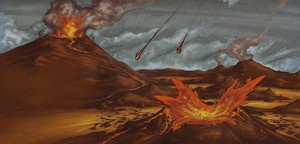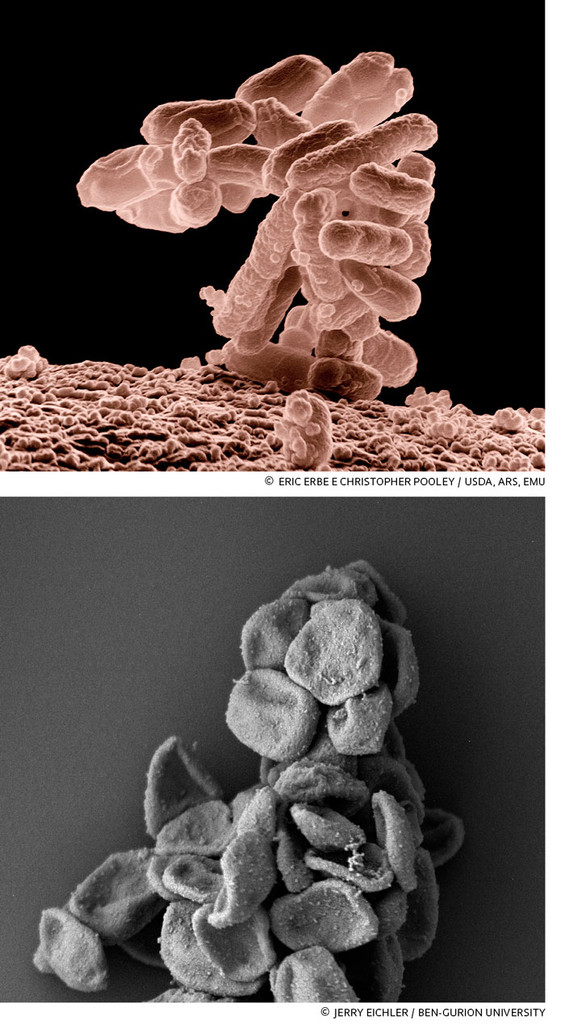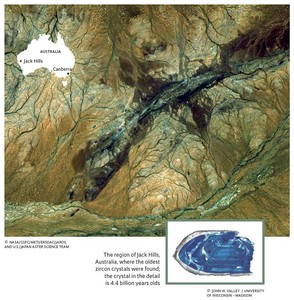 Sandro CastelliVarious artistic representations show an Earth full of volcanoes being bombarded by meteors during the Hadean Eon, a geological period that lasted from 4.6 billion to 4 billion years ago. This is what the planet is believed to have looked like when life emerged, in forms which were still simple. The current understanding is that oceans of magma or hydrothermal vents, cracks in the Earth’s crust that spew extremely hot water at the bottom of the ocean or the surface of the planet, could be favorable environments for driving important chemical reactions that formed complex, self-replicating molecules: the basis of life. There is no consensus on this subject, partly because few traces (whether geological or biological) remain that would allow us to reconstruct this period in the history of the planet. Scientists generally look for clues about the Hadean Eon in rocks, but the geological engineer Carlos Roberto de Souza Filho and his team at the Institute of Geosciences at the University of Campinas (IGE-UNICAMP) decided to see what modern bacteria and other single-celled organisms had to say about the period, and they reached a different conclusion. “There is a strong possibility that life also emerged on emersed land,” maintains Souza Filho, based on results published in June in Scientific Reports.
Sandro CastelliVarious artistic representations show an Earth full of volcanoes being bombarded by meteors during the Hadean Eon, a geological period that lasted from 4.6 billion to 4 billion years ago. This is what the planet is believed to have looked like when life emerged, in forms which were still simple. The current understanding is that oceans of magma or hydrothermal vents, cracks in the Earth’s crust that spew extremely hot water at the bottom of the ocean or the surface of the planet, could be favorable environments for driving important chemical reactions that formed complex, self-replicating molecules: the basis of life. There is no consensus on this subject, partly because few traces (whether geological or biological) remain that would allow us to reconstruct this period in the history of the planet. Scientists generally look for clues about the Hadean Eon in rocks, but the geological engineer Carlos Roberto de Souza Filho and his team at the Institute of Geosciences at the University of Campinas (IGE-UNICAMP) decided to see what modern bacteria and other single-celled organisms had to say about the period, and they reached a different conclusion. “There is a strong possibility that life also emerged on emersed land,” maintains Souza Filho, based on results published in June in Scientific Reports.
The work is the result of a meeting between geochemistry and biology. During a post-doctoral internship in Souza Filho’s lab, the geochemist Alexey Novoselov created numerical simulations using information about some chemical characteristics of modern bacteria and archaea. Today’s bacteria and archaea are comprised of a single cell and descend from a common ancestor—possibly the last universal common ancestor, or LUCA—that may have existed around 4 billion years ago, shortly after life appeared on Earth. Even though they diverged long ago, these two groups of living beings maintain concentrations which are very similar to certain inorganic chemical compounds, such as silicon dioxide (SiO2), titanium hydroxide (Ti(OH)4), calcium ions (Ca2+), magnesium ions (Mg2+), and sulfate ions (SO42-). In recent years, some researchers began to suggest that this similarity might indicate the chemical composition of the common ancestor, which in turn would reflect the chemical conditions of the environment in which it lived.
The little that is known of the Hadean Eon comes from chemical analysis of small crystals of zircon found in Jack Hills, Australia, which formed about 4.4 billion years ago. These crystals have been studied thoroughly and indicate that there was oxidation in the Earth’s mantle, suggesting the existence of liquid water at that time. In partnership with researchers from Chile, Argentina, the United States, and Germany, Novoselov, Souza Filho and other collaborators from UNICAMP looked for additional information about this primitive Earth by examining the chemical composition shared by bacteria and archaea. Archaea are single-celled organisms that had previously been classified in the same group as bacteria but in the late 1970s were put into their own separate group. “We try to identify the characteristics of the environment in the Hadean which were preserved in the metabolism of the bacteria and archaea, the most primitive organisms that exist today,” explains Souza Filho, who is also a professor at UNICAMP.
 The organisms the group chose were five species of bacteria (Acetobacter aceti, Alicycloba-cillus acidoterrestris, Escherichia coli, Nesterenkonia lacusekhoensis, and Vibrio cholerae) and two species of archaea living in hypersaline environments (Haloferax volcanii and Natrialba magadii). They chose to work with bacteria and archaea because no organisms remain from the Hadean Eon, and the oldest preserved fossils date back to a more recent period, the Archean, which lasted from 4 billion to 2.5 billion years ago.
The organisms the group chose were five species of bacteria (Acetobacter aceti, Alicycloba-cillus acidoterrestris, Escherichia coli, Nesterenkonia lacusekhoensis, and Vibrio cholerae) and two species of archaea living in hypersaline environments (Haloferax volcanii and Natrialba magadii). They chose to work with bacteria and archaea because no organisms remain from the Hadean Eon, and the oldest preserved fossils date back to a more recent period, the Archean, which lasted from 4 billion to 2.5 billion years ago.
Through high-precision geochemical analyses using mass spectrometry, the researchers quantified the inorganic chemical elements that these species of bacteria and archaea share. The group also cultivated microorganisms in culture media with differing compositions, which allowed them to measure how much of these chemical elements they absorb from the environment and how much is passed from one generation to another. According to the researchers, this information could allow us to draw conclusions about the conditions in which the putative common ancestor to all organisms arose, which was proposed some years ago by the biologist Jack Trevors, professor emeritus at the University of Guelph in Canada.
The results obtained by Souza Filho’s team indicate that the metabolism of bacteria and the archaea does in fact retain a chemical signature of the environment in which they developed. Because these living beings share metabolic pathways that most likely emerged billions of years ago and use the same inorganic components, the researchers looking at these components saw the planet’s distant past. “We may have possibly obtained the oldest evidence that there is a connection between living beings and the mineral world,” says Novoselov, who currently is a researcher at the Institute of Economic and Applied Geology in Chile.

Colony of Escherichia coli, bacteria that may have shared a common ancestor with archaea (on top). Examples of the Haloferax volcanii species of archaea, which is found in hypersaline environments
“Was this ancestor formed in the presence of basaltic rocks, komatiite rocks, or some other type of volcanic lava?” asks Souza Filho, giving an example of some of the questions asked by the research group. If bacteria and archaea acquired certain elements, this means that the minerals they contain should be present in the original environment. The results corroborate what was projected by the zircon crystal models, and suggest that the first life forms emerged in a mild climate with wet and dry seasons, in an atmosphere with less carbon dioxide (CO2) than is found today. The stage for this emergence was believed to have been in land-based environments, such as cavities in rocks (probably basalts) where the microorganisms could protect themselves.
This result favors the hypothesis that life could have arisen on rocks exposed to elements like rain and wind, in a small hot pond, as the English naturalist Charles Darwin proposed in the nineteenth century, or in hydrothermal vents on land, according to a later hypothesis supported by some researchers. In all of these cases, the characteristic molecules of living beings (proteins, lipids, and DNA, for example) require oscillations between moisture and dryness to form, something that could only occur on emersed land and not in the sea. Other groups disagree, maintaining that life originated in the primitive ocean, or as proposed over recent decades, in even more inhospitable regions such as hydrothermal vents in deep regions of the ocean.
Souza Filho recognizes that the scenario which was imagined from these results is hypothetical, and does not rule out the possibility that primordial life forms also emerged at high temperatures. “Extremophiles, organisms that live in very adverse conditions, provide an interesting lesson from which a number of ideas spring, for example that ultrahot or ultrasaline places are full of life and a great niche for scientific exploration,” he adds. He also sees some possible extraplanetary consequences of his conclusions. “The atmosphere of Mars was similar to that of Earth when it was older,” he says. “A better understanding of how life arose and evolved on Earth puts into perspective the possibility that there may be life in conditions outside our planet, and by analogy, [allows us to] select planets and regions that may be more favorable for finding it,” he says.
 An ocean in the lab
An ocean in the lab
This reflection may be relevant for the possibility that extraterrestrial life exists, as well as the notion that it may have arrived to Earth from other points in the universe, a hypothesis known as panspermia (see Pesquisa FAPESP, issue No. 193). “For the time being, it is impossible to say whether life arose on our planet or elsewhere,” says chemist Dimas Zaia, a professor at the State University of Londrina (UEL). Assuming that life arose here, Zaia tries to recreate the conditions that allowed this development to occur in the laboratory. This does not necessarily mean reproducing the past. “We will never know exactly how life arose, because we do not have precise information about the Earth in that period,” he says. “But we can show that life can be synthesized from inanimate matter.”
To do this, Zaia developed a type of seawater called 4 bi water that contains compounds and ions which are thought to have been abundant at that time, such as sulfate, magnesium, and calcium ions. “Everything I have done in the past three years has been with this water.” The experiments involve dissolving substances in this water under different conditions and observing what happens from a chemical point of view.
Zaia’s group recently showed that modern seawater causes the collapse of nanometer-sized cavities which are present in clay particles, reducing the possibility that chemical reactions will occur between molecules attached to them. But the 4 bi water does not degrade the mineral, an observation which corroborates the hypothesis that it would be conducive to the origin of life. “Organic molecules are very diluted in the sea, so they need to concentrate themselves into particles in order to meet and form polymers,” he explains. Besides clay, several other minerals remain stable in 4 bi water at both ambient temperature and at 80 degrees Celsius, and also shelter magnesium and potassium ions on its surface—conditions which are conducive to the formation of polymers, as indicated by an article published online in late 2016 in the journal Origins of Life and Evolution of the Biosphere. The mineral fragments act as catalysts that also protect the molecules from ultraviolet radiation (there was no ozone layer in the Earth’s early days) and from degradation by hydrolysis.
Together, experiments with bacteria and chemical reactions in the water can help reconstruct past environments and suggest how they may have led to the formation of life.
Project
Quantifying the constraints on the environment of early Earth: The cradle for emerging life on a young planet (No. 11/12682-3); Grant Mechanism PhD Grant; Principal Investigator Carlos Roberto de Souza Filho (UNICAMP); Scholarship Recipient Alexey Novoselov; Investment R$249,462.97
Scientific articles
NOVOSELOV, A. A. et al. Geochemical constraints on the Hadean environment from mineral fingerprints of prokaryotes. Scientific Reports. V. 7, 4008. June 21, 2017.
CARNEIRO, C. E. A. et al. Interaction at ambient temperature and 80 °C, between minerals and artificial seawaters resembling the present ocean composition and that of 4.0 billion years ago. Origins of Life and Evolution of the Biosphere. Online. Oct. 14, 2016.